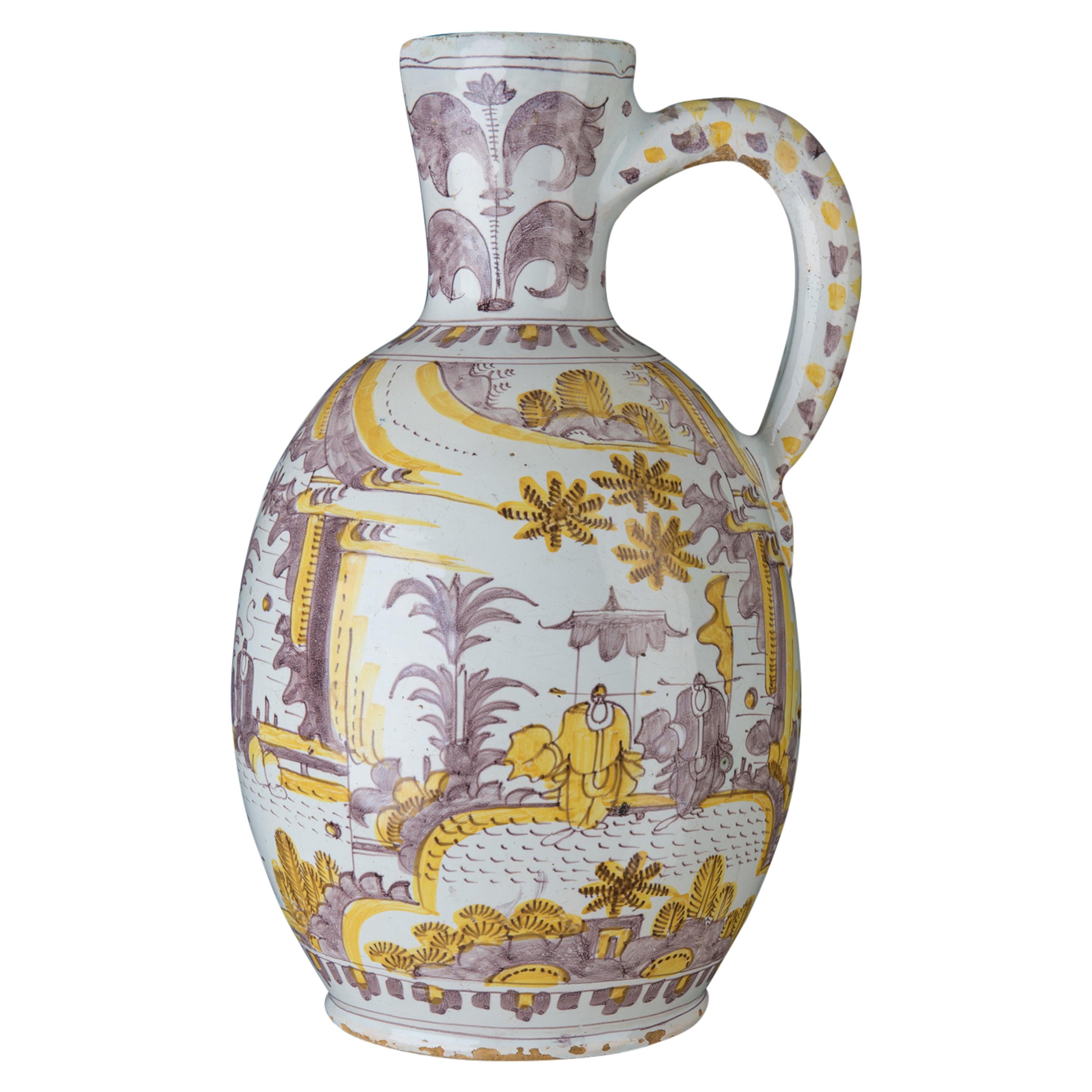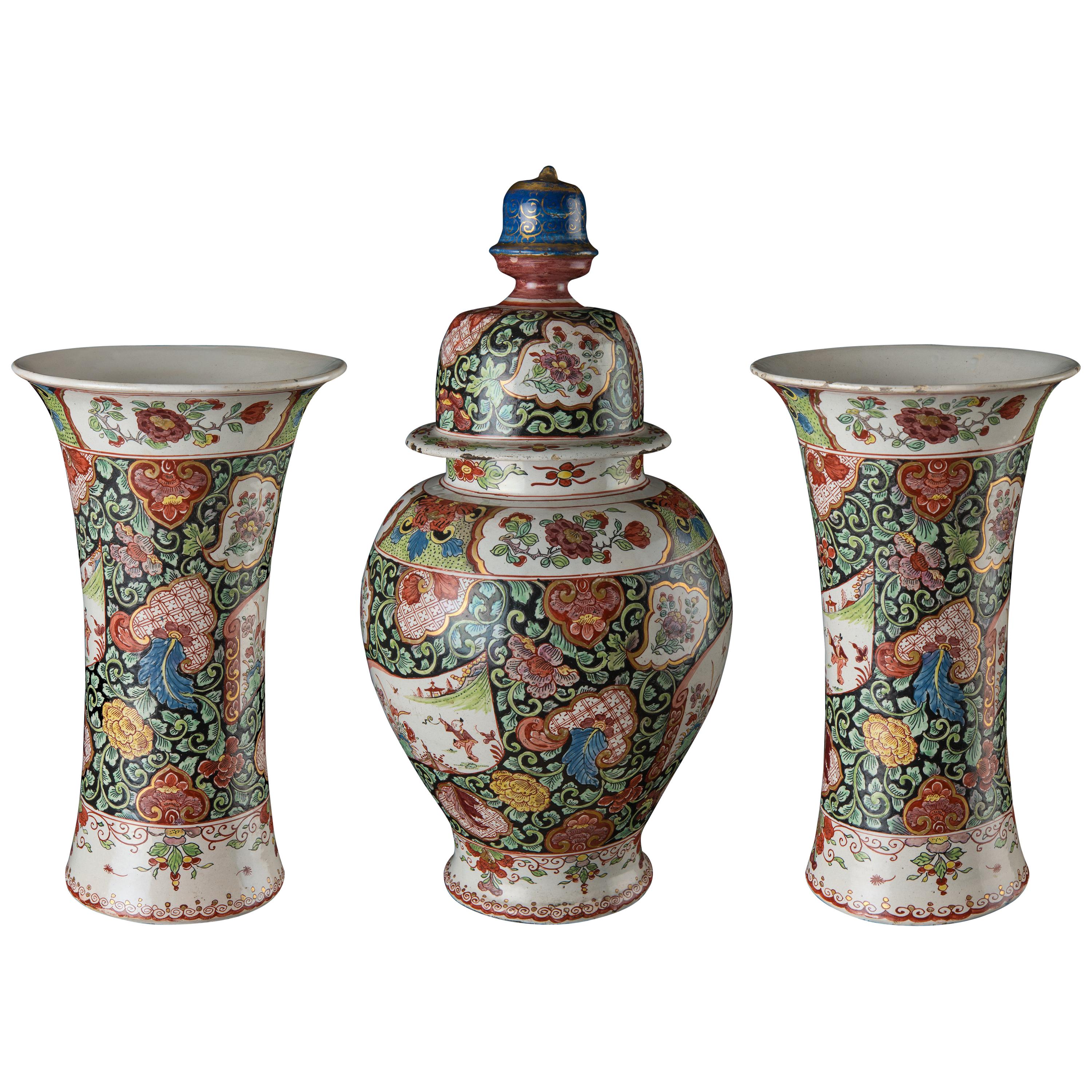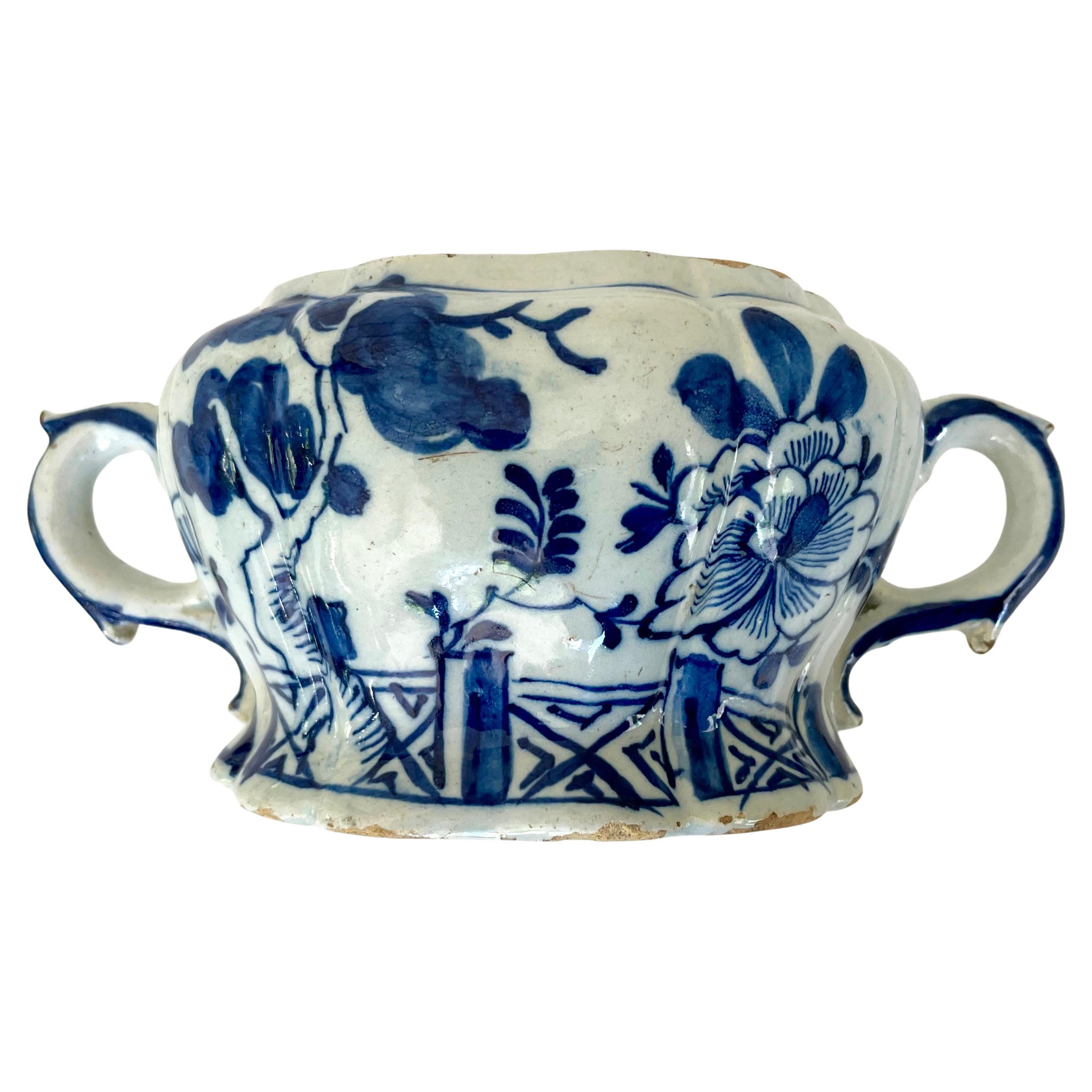Items Similar to Delft, Blue and White floral Chinoiserie Jar, 1650-1680
Video Loading
Want more images or videos?
Request additional images or videos from the seller
1 of 9
Delft, Blue and White floral Chinoiserie Jar, 1650-1680
About the Item
The ovoid jar stands on a slightly spreading foot, has a short upright neck, and is painted in blue with a floral decor. Three large cartouches containing flower bouquets have been applied to the belly, separated from each other by panels with flowers, bands and strips. Elements that resemble a window and a panelled cupboard are painted on the right side of each cartouche. The shoulder has a broad band with four panels, filled with two types of double flowers, separated from each other by a leaf on a blue background. Ornaments are applied to the neck. A band with stylized leaves is painted above the foot.
The floral decoration is inspired by porcelain from the period of the last Ming emperor Chongzhen (1628-1644). The flowers and plants on Delft pottery from the period 1650-1680 are much more exuberant and rendered more naturalistically than on the Chinese originals.
Dimensions: Height 23 cm / 9.05 in., diameter 19 cm / 7.48 in.
This vase is about 350 years old and has the usual wear to top and bottom rim. The vase has a consolidated hairline crack, clearly visible on one of the pictures.
I carefully package all items in a double-box and use first class packaging material.
- Creator:Dutch Originals (Maker)
- Dimensions:Height: 9.05 in (22.99 cm)Diameter: 7.48 in (19 cm)
- Style:Baroque (Of the Period)
- Materials and Techniques:
- Place of Origin:
- Period:
- Date of Manufacture:1650-1680
- Condition:Wear consistent with age and use. This vase is about 350 years old and has the usual wear to top and bottom rim. The vase has a consolidated hairline crack, clearly visible on one of the pictures.
- Seller Location:Verviers, BE
- Reference Number:1stDibs: LU1441224730722
About the Seller
4.9
Platinum Seller
These expertly vetted sellers are 1stDibs' most experienced sellers and are rated highest by our customers.
Established in 2000
1stDibs seller since 2015
696 sales on 1stDibs
Typical response time: 2 hours
- ShippingRetrieving quote...Ships From: Velddriel, Netherlands
- Return PolicyA return for this item may be initiated within 3 days of delivery.
More From This SellerView All
- Delft, Large Blue and White Armorial Charger, 1650-1680By Dutch OriginalsLocated in Verviers, BEBlue and white armorial charger. Delft or Haarlem, 1650-1680 This large charger has a wide-spreading flange and is decorated in the center with a c...Category
Antique Mid-17th Century Dutch Baroque Delft and Faience
MaterialsCeramic, Faience
- Delft, Purple and Yellow Chinoiserie Jug, circa 1680-1700By Dutch OriginalsLocated in Verviers, BEPurple and yellow chinoiserie jug. Delft, circa 1680 - 1700 The ovoid jug stands on a lightly spreading foot and has a tapered neck with spout. The top of the handle is pierced for a metal mount. The jug is painted in purple and yellow with a continuous chinoiserie landscape with Chinese figures. Bands with rectangular ornaments between double circles are applied on the shoulder and just above the foot. The neck is painted with a double leaf motif. The handle is decorated with stripes and dots, alternately applied in purlple and yellow. Purple or multi-coloured Delftware with chinoiserie landscapes are relatively rare, though versions in blue and purple, blue and yellow, green and purple are known, as well as three colour combinations like purple, yellow and green. A butter pot in this last colour combination was excavated from a cesspit in the grounds of the former Porcelain Bottle pottery in Delft. Multi-coloured chinoiserie decorations are painted especially on lobed dishes and also on beer mugs, covered spiced wine bowls and small plates. A purple, yellow and green painted beer mug in the Princessehof Ceramics Museum in Leeuwarden, The Netherlands, combines a chinoiserie landscape with a depiction of stadtholder prins Willem III...Category
Antique Late 17th Century Dutch Baroque Delft and Faience
MaterialsCeramic, Faience
- Blue and White Chinoiserie Wine Jug Delft, 1650-1670By Dutch OriginalsLocated in Verviers, BEBlue and white chinoiserie wine jug Delft, 1650-1670 The ovoid-shaped wine jug stands on a waisted foot and has a slightly conical neck with a spo...Category
Antique Mid-17th Century Dutch Baroque Delft and Faience
MaterialsCeramic, Faience
- Delft, Blue and White Chinoiserie Altar Vase, circa 1685By Dutch OriginalsLocated in Verviers, BEBlue and white chinoiserie altar vase. Delft, circa 1685 The ovoid altar vase stands on a high-waisted foot. The flaring cylindrical neck ends in an outward sloping mouth rim. The two blue coloured lion-shaped handles have suspending rings in their jaws. The body is painted with a continuous oriental landscape with banana and pine trees, Chinese figures and houses, while the neck is painted with three bands of different ornaments. The mouth rim is decorated with rectangular ornaments, the foot with leaves under a band around the ankle. Altar vases are also called vases à chimères. The oldest faience examples were made in the sixteen-twenties in Nevers, France and are attributed to the Conrade potters family, who originated from Italy. The shape is based on metal vases used during the services in Catholic churches. Therefore it is no wonder that many altar vases are painted with the Christogram IHS. Altar vases were made in Delft from about 1675 onwards and production continued well into the eighteenth century. Marked examples are known from multiple manufacturers, such as The Greek A and The Moor’s Head potteries (Aronson 2011, pp. 14-15). A pair of eighteenth century vases was made between 1700 and 1716 at The Three Porcelain Ash Barrells pottery. They are marked with PK for the owner Pieter Kam or, after 1705, by his widow (Blazy & Boyazoglu 1983, p. 110). The pair is painted with a dense parsley decor. A miniature example was excavated from a cesspit in the grounds of the former Porcelain Bottle pottery in Delft. At the same location a larger fragment was also found, decorated with a triple-tulip design in blue and yellow (Eliëns, Schledorn, Van Aken-Fehmers, pp. 31 , 36, 45). Three altar vases with similar tulip and flower decoration in blue and yellow are in the collection of the Dutch Open Air Museum in Arnhem and can also be attributed to the Porcelain Bottle pottery (Klein, p. 152). Official Catholic services were not allowed in the seventeenth century in the Dutch republic, however Catholic conventicles were tolerated. At first sight it might be surprising that a Catholic object...Category
Antique Late 17th Century Dutch Baroque Delft and Faience
MaterialsCeramic, Faience
- Delft, Pair of Blue and White Chinoiserie Dishes, 1680 - 1700By Dutch OriginalsLocated in Verviers, BEPair of blue and white chinoiserie dishes. Delft 1680-1700. [attributed to] The Three Porcelain Ash Barrels pottery Pair of blue and white dishes with a wide-spreading flange, t...Category
Antique Late 17th Century Dutch Baroque Delft and Faience
MaterialsCeramic, Faience
- Delft, Chinoiserie Famille Rose Garniture, 1730-1740By Dutch OriginalsLocated in Verviers, BE3 piece chinoiserie Famille rose garniture, Delft, 1730-1740 This petit feu garniture consists of a baluster vase with cover and two beaker vases. The cover has a bell-shaped knob...Category
Antique Early 18th Century Dutch Baroque Delft and Faience
MaterialsCeramic, Faience
You May Also Like
- Blue and White Delft Handled Chinoiserie VaseBy DelftLocated in New York, NYBlue and white Delft handled chinoiserie vase. Antique Dutch porcelain vase with rich blue flowers and chinoiserie fencing in a lustrous glaze; with scro...Category
Antique Late 18th Century Dutch Chinoiserie Delft and Faience
MaterialsCeramic
- Delft 1760-1780 Blue and White Duynkerker Tobacco Jar DelftwareBy DelftLocated in ROSSUM, GEBlue and white DUYNKERKER tobacco jar Delft, 1760-1780 The ovoid tobacco jar with copper lid has a groove on the shoulder at the top and a protruding rim. The jar is painted in blue...Category
Antique Late 18th Century Dutch Baroque Delft and Faience
MaterialsCeramic, Faience
- Blue and White Dutch Delft Lidded Jar in Chinoiserie, Early 18th CenturyBy DelftLocated in AMSTERDAM, NHAn Early Dutch Delftware lidded jar with chinoiserie decoration. Origine: Delft, The Netherlands Date: Early 18th century Workshop: Unknown. A genuine blue and white lidded j...Category
Antique Early 18th Century Dutch Chinoiserie Delft and Faience
MaterialsCeramic, Delft, Faience
- Blue and White Delft Mantle Jar Netherlands circa 1780Located in Katonah, NYThis charming blue and white Dutch Delft jar is decorated in shades of cobalt blue. Hand-painted in the late 18th century circa 1780, the jar mixes rococo and chinoiserie design elem...Category
Antique Late 18th Century Dutch Jars
MaterialsDelft
- Delft 1750 - 1800 Large Blue and White Tobacco Jar ‘No. 12’ Mark: LpkanBy DelftLocated in ROSSUM, GEBlue and white tobacco jar ‘No. 12’ Delft, 1750-1800 The Lampet Jug pottery Mark: LPKan The ovoid tobacco jar has a protruding rim and...Category
Antique Late 18th Century Dutch Baroque Delft and Faience
MaterialsCeramic, Faience
- Very Large Blue and White Delft Jar Belgium circa 1880By Boch Freres KeramisLocated in Katonah, NYThis fabulous Delft jar is painted with traditional deep cobalt blue on a tin-glazed ground. The jar has six panels, which alternate between flowers in a basket and ferns with scroll...Category
Antique Late 19th Century Belgian Jars
MaterialsDelft
Recently Viewed
View AllMore Ways To Browse
Double Flower
Dutch Kitchen
Blue And White Foot
Dutch Baroque Furniture
White Faience And Delft
Antique Faience Pottery
Chinoiserie Blue White
Blue And White Chinoiserie
Delft Flowers
Blue And White Faience Delft
Dutch Delft Blue And White
Holland Pottery
Dutch Blue Ceramics
Large Delft
Dutch Decor
Dutch 17th Century Large
Antique Painted Glass Pictures
Holland Dutch Pottery





